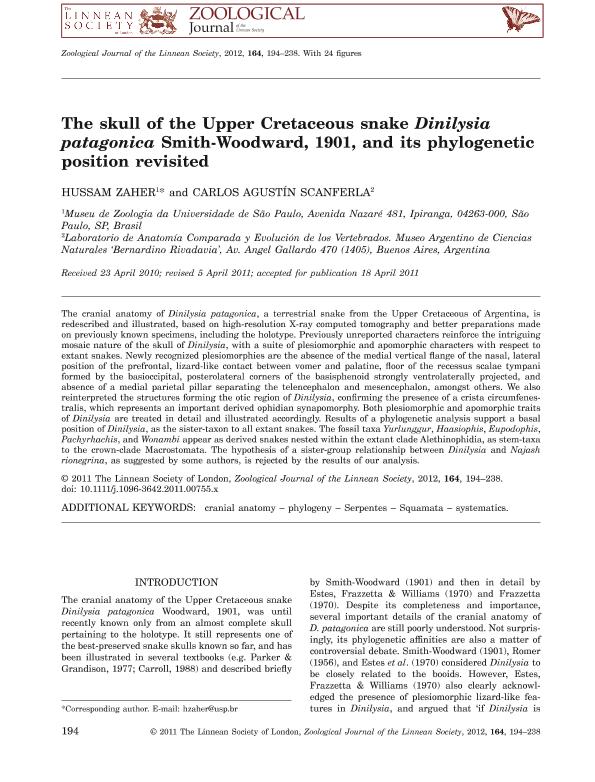Mostrar el registro sencillo del ítem
dc.contributor.author
Zaher, Hussam
dc.contributor.author
Scanferla, Carlos Agustín

dc.date.available
2018-07-13T15:40:02Z
dc.date.issued
2012-01
dc.identifier.citation
Zaher, Hussam; Scanferla, Carlos Agustín; The skull of the Upper Cretaceous snake Dinilysia patagonica Smith-Woodward, 1901, and its phylogenetic position revisited; Wiley Blackwell Publishing, Inc; Zoological Journal of the Linnean Society; 164; 1; 1-2012; 194-238
dc.identifier.issn
0024-4082
dc.identifier.uri
http://hdl.handle.net/11336/52021
dc.description.abstract
The cranial anatomy of Dinilysia patagonica, a terrestrial snake from the Upper Cretaceous of Argentina, is redescribed and illustrated, based on high-resolution X-ray computed tomography and better preparations made on previously known specimens, including the holotype. Previously unreported characters reinforce the intriguing mosaic nature of the skull of Dinilysia, with a suite of plesiomorphic and apomorphic characters with respect to extant snakes. Newly recognized plesiomorphies are the absence of the medial vertical flange of the nasal, lateral position of the prefrontal, lizard-like contact between vomer and palatine, floor of the recessus scalae tympani formed by the basioccipital, posterolateral corners of the basisphenoid strongly ventrolaterally projected, and absence of a medial parietal pillar separating the telencephalon and mesencephalon, amongst others. We also reinterpreted the structures forming the otic region of Dinilysia, confirming the presence of a crista circumfenestralis, which represents an important derived ophidian synapomorphy. Both plesiomorphic and apomorphic traits of Dinilysia are treated in detail and illustrated accordingly. Results of a phylogenetic analysis support a basal position of Dinilysia, as the sister-taxon to all extant snakes. The fossil taxa Yurlunggur, Haasiophis, Eupodophis, Pachyrhachis, and Wonambi appear as derived snakes nested within the extant clade Alethinophidia, as stem-taxa to the crown-clade Macrostomata. The hypothesis of a sister-group relationship between Dinilysia and Najash rionegrina, as suggested by some authors, is rejected by the results of our analysis. © 2011 The Linnean Society of London.
dc.format
application/pdf
dc.language.iso
eng
dc.publisher
Wiley Blackwell Publishing, Inc

dc.rights
info:eu-repo/semantics/openAccess
dc.rights.uri
https://creativecommons.org/licenses/by-nc-sa/2.5/ar/
dc.subject
Cranial Anatomy
dc.subject
Phylogeny
dc.subject
Serpentes
dc.subject
Squamata
dc.subject
Systematics
dc.subject.classification
Meteorología y Ciencias Atmosféricas

dc.subject.classification
Ciencias de la Tierra y relacionadas con el Medio Ambiente

dc.subject.classification
CIENCIAS NATURALES Y EXACTAS

dc.title
The skull of the Upper Cretaceous snake Dinilysia patagonica Smith-Woodward, 1901, and its phylogenetic position revisited
dc.type
info:eu-repo/semantics/article
dc.type
info:ar-repo/semantics/artículo
dc.type
info:eu-repo/semantics/publishedVersion
dc.date.updated
2018-07-11T14:10:17Z
dc.journal.volume
164
dc.journal.number
1
dc.journal.pagination
194-238
dc.journal.pais
Reino Unido

dc.journal.ciudad
Londres
dc.description.fil
Fil: Zaher, Hussam. Universidade de Sao Paulo; Brasil
dc.description.fil
Fil: Scanferla, Carlos Agustín. Consejo Nacional de Investigaciones Científicas y Técnicas. Oficina de Coordinación Administrativa Parque Centenario. Museo Argentino de Ciencias Naturales “Bernardino Rivadavia”; Argentina
dc.journal.title
Zoological Journal of the Linnean Society

dc.relation.alternativeid
info:eu-repo/semantics/altIdentifier/doi/https://dx.doi.org/10.1111/j.1096-3642.2011.00755.x
dc.relation.alternativeid
info:eu-repo/semantics/altIdentifier/url/https://academic.oup.com/zoolinnean/article/164/1/194/2627169
Archivos asociados
